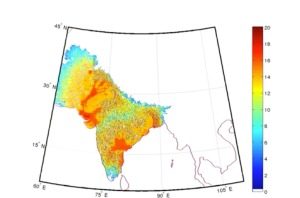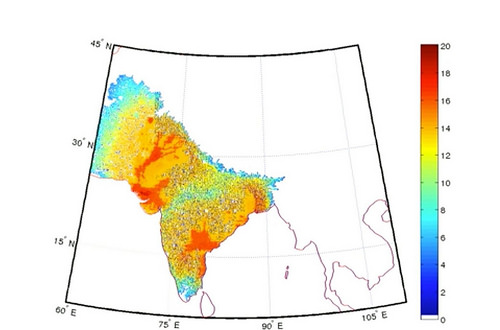
TATA INSTITUTE OF FUNDAMENTAL RESEARCH—Prehistoric human migration was mainly driven by human wanderlust and population pressures but relied critically on the habitability of available land. We have modelled such prehistoric population dynamics using a diffusion equation whose numerical solution is tempered by accurate geological data for the Indian subcontinent taken from satellite databases.
We define the driving forces by assuming that people will move out of any given region if the neighbouring regions are habitable. In turn, we define habitability by quantifying parameters like the availability and proximity of water, and flatness and altitude of the land. We define relative habitability which takes into account the presence of the initial population. We then consult the archaeological evidence of early humans in the subcontinent and identify three possible locations in Kabul which would represent the Ancestral North Indian entry into India, Hyderabad which would represent the earliest Ancestral South Indian population into India and we take two possible entry points for Ancestral Austro Asiatic as Goa and Orissa identified as two major break points in the mountain range that mark the Indian Subcontinent for people coming to India along the coast.
We find that people entering from Goa would soon become indistinguishable from the original Ancestral South Indian population. We therefore focus on entry from Orissa. On simulating the movement of these people we find that the groups merge in well localised geographical regions within the subcontinent. We then analyse the genetic data of the tribal population of the region. Since these groups are largely endogamous, they maintain their original genetic signal with very weak dilution due to intermixing. This allows us to identify the roots of different groups and compare it with our simulation. The genetic data agrees well with our predictions. We then expand our simulation to show that over a long period of time, the pattern of population that appears, agrees well with the present population of India.
________________________________________
Image shows one stage in the movement of people into the hinterland of the Indian subcontinent starting from Kabul, Hyderabad and North Orissa. Credit: Vahia, Yadav, Ladiwala, Mathur
_____________________________________________________
Article Source: Tata Institute of Fundamental Research news release
_____________________________________________________
Subscribe to Popular Archaeology Premium. Available on all laptops and mobile devices, and still the industry’s best value at only $9.00 annually.
___________________________________________
Travel and learn with Far Horizons.
____________________________________________
This richly illustrated issue includes the following stories: Recent findings shedding new light on the whereabouts of the remains of Philip of Macedon, father of Alexander the Great; how an archaeologist-sculptor is bringing bones of the dead back to life; archaeologists uncovering town life at the dawn of civilization; an exclusive interview with internationally acclaimed archaeologist James M. Adovasio about what makes the Meadowcroft Rockshelter prominent in the ongoing search for the first Americans; what archaeologists are finding at the site of the ancient city of Gath, the home town of the biblical Philistine giant, Goliath; and how scientists are redrawing the picture of human evolution in Europe. Find it on Amazon.com.








